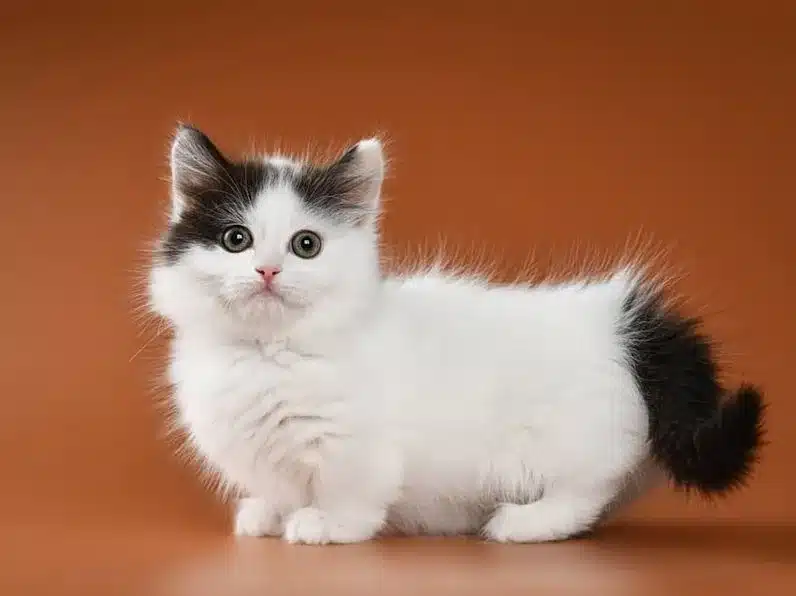Munchkin Cats Breed Guide: History, Personality, Care [2024]
Munchkin cats capture attention with their distinctive short legs, a result of a genetic mutation. This breed stands out in the feline world, combining a small stature with an energetic and playful nature.
The Munchkin cat’s unique appearance and friendly demeanor make it a favorite among cat enthusiasts. Despite its relatively recent emergence in the world of pedigreed cats, the Munchkin has quickly garnered a dedicated following for its endearing qualities and adaptability as a pet.
Origins and History
The Munchkin cat’s journey from a genetic anomaly to a recognized breed is a fascinating story. The breed’s defining trait, its short legs, is due to a natural genetic mutation. The first documented Munchkin, a stray named Blackberry, was discovered in Louisiana in the 1980s.
Her offspring exhibited the same short-legged trait, leading to the deliberate breeding of Munchkin cats. Despite its popularity, the breed faced skepticism and was only officially recognized by The International Cat Association (TICA) in the late 20th century.
Both allure and controversy mark the breed’s history, as debates over the ethics of breeding Munchkin cats continue.
Physical Characteristics
Munchkin cats are instantly recognizable by their short legs, a trait that defines the breed. They exhibit a range of sizes, typically weighing between 6 and 9 pounds, making them small to medium-sized cats.
Their legs, short due to the genetic mutation of chondrodysplasia, don’t hinder their mobility or zest for life. Munchkins come in both short-haired and long-haired varieties, each with its own grooming needs.
The short-haired Munchkin boasts a plush, medium-length coat, while the long-haired variety has a semi-long, silky coat. Their coat can be any color or pattern, reflecting the breed’s diverse genetic background.
The body structure of Munchkin cats, including their leg length and body proportion, adds to their distinctive and appealing appearance.
Personality and Behavior
Beyond their charming looks, Munchkin cats possess a lively and affectionate personality. They are known for their social nature, often seeking out the company of humans and other animals.
These cats are intelligent and curious, frequently engaging in playful antics that endear them to their owners. Despite their small size, Munchkins are agile and enjoy activities like running and playing fetch.
They adapt well to indoor living but require mental stimulation and physical play to stay happy and healthy. Their friendly disposition makes them excellent companions, thriving in environments where they receive attention and interaction.
Health and Care
Munchkin cats, despite their unusual appearance, generally enjoy good health, with a life expectancy comparable to other domestic cats, around 12 to 15 years.
However, they are susceptible to specific health issues related to their short stature, such as lordosis (a curvature of the spine) and pectus excavatum (a condition where the chest is sunken). Regular veterinary check-ups are crucial to monitor and manage these potential health problems.
Caring for a Munchkin cat involves regular grooming, especially for long-haired varieties, to prevent matting and tangles. Their activity should be monitored to prevent obesity, which can exacerbate health issues related to their unique physique.
Munchkin cats’ playful and curious nature means they require a stimulating environment with toys and activities to keep them engaged. Providing a safe and nurturing environment will help maintain their physical and mental health.
Munchkin Cats in the Home
Munchkin cats are well-suited to family life, often forming strong bonds with their owners and other pets. Their friendly and adaptable nature makes them great companions in a variety of home settings.
However, due to their small size and short legs, accommodations may be needed to ensure their environment is accessible and safe. This includes using litter boxes with low sides and ensuring that food and water bowls are easily reachable.
Their sociable personality means Munchkin cats do not like being left alone for long periods.
Prospective owners should consider this when adopting or purchasing a Munchkin, especially if they have a busy lifestyle. Having another pet in the home or ensuring regular human interaction can help keep a Munchkin cat happy and content.
Frequently Asked Questions (F.A.Q)
How long do Munchkin cats live?
Munchkin cats have a life expectancy similar to other domestic cats, typically ranging from 12 to 15 years, with proper care and regular veterinary check-ups.
Can Munchkin cats jump and climb like other cats?
While they can jump and climb, their short legs may limit the height they can reach compared to other cats. Providing steps or ramps can help them access higher places safely.
Are Munchkin cats good with children and other pets?
Yes, Munchkin cats are known for their sociable and affectionate nature, making them good companions for children and other pets. However, interactions should always be supervised, especially with young children, to ensure gentle play.
Wrapping Up
The Munchkin cat, with its distinctive short legs and spirited personality, offers a unique addition to the feline world. These cats, while requiring some special considerations for their physical attributes, provide affection and entertainment in equal measure. When considering bringing a Munchkin into your home, it’s essential to prioritize their health and happiness, choosing ethical breeding practices and providing a nurturing environment. Whether you’re drawn to their playful nature or captivated by their unusual appearance, a Munchkin cat can be a delightful and loving companion.


![How Much Does a Munchkin Cat Cost? [2024]](https://catscuddle.com/wp-content/uploads/2024/03/How-Much-Does-a-Munchkin-Cat-Cost-768x510.webp)
![Munchkin Cat Life Expectancy: How Long Do They Live? [2024]](https://catscuddle.com/wp-content/uploads/2024/03/Munchkin-Cat-Life-Expectancy-768x512.webp)
![Torbie Cat: History & Origin, Personality, Care [2024]](https://catscuddle.com/wp-content/uploads/2024/03/Torbie-Cat-1-768x432.webp)

![What are Magpie Cats? – Breed, Personality, Care [2024]](https://catscuddle.com/wp-content/uploads/2024/03/What-are-Magpie-cats-768x441.webp)
![Dilute Tortie – What Makes Them So Special? [2024]](https://catscuddle.com/wp-content/uploads/2024/03/Dilute-Tortie-3-768x490.webp)